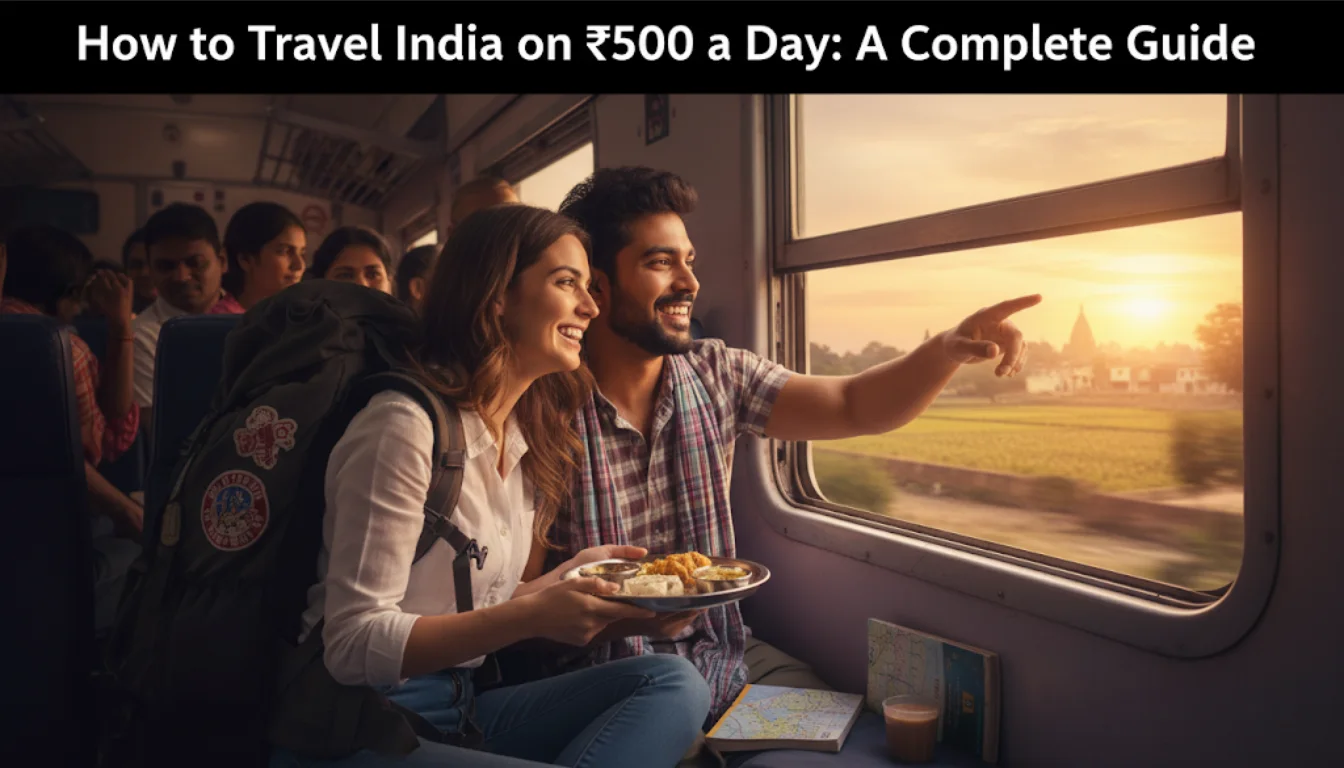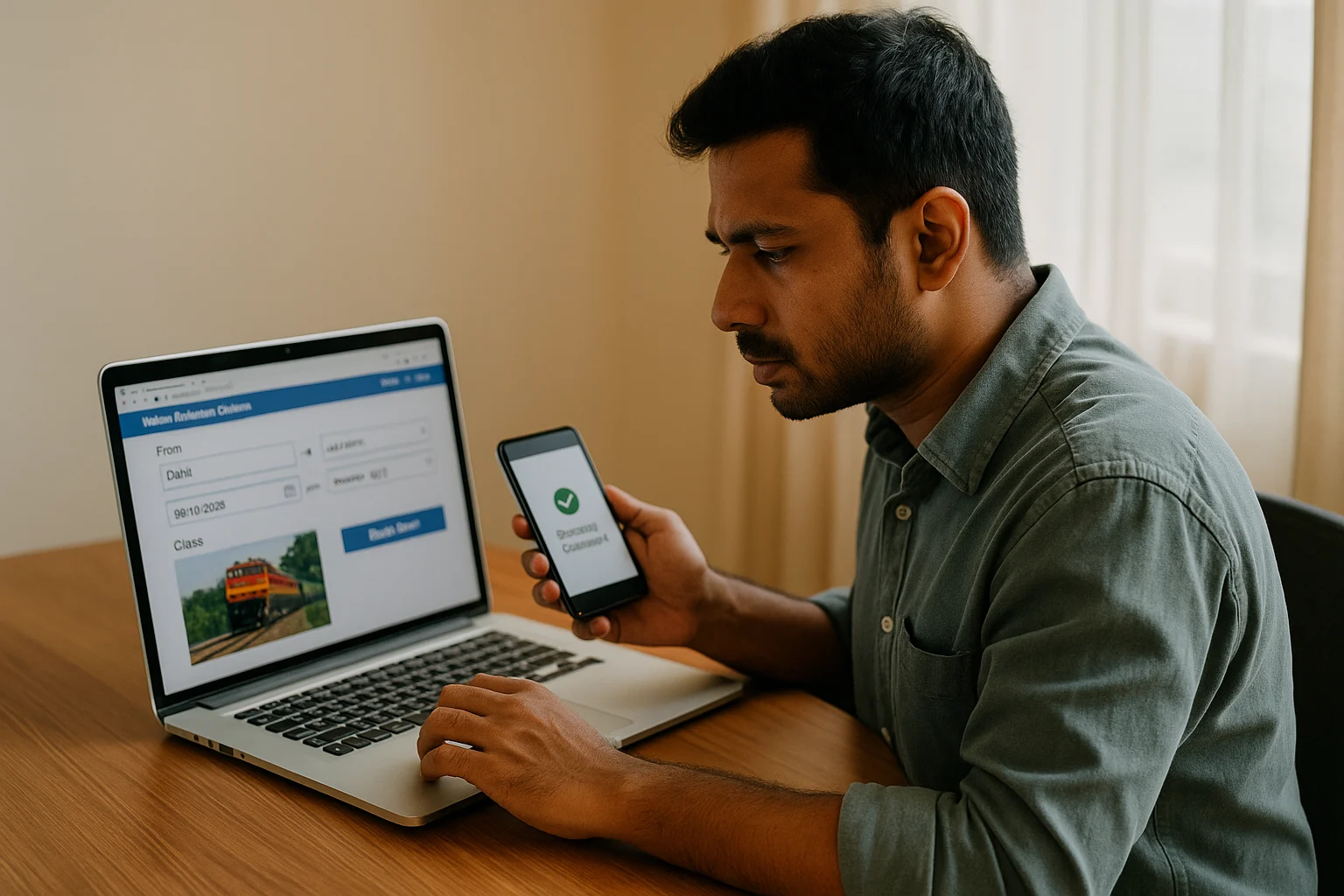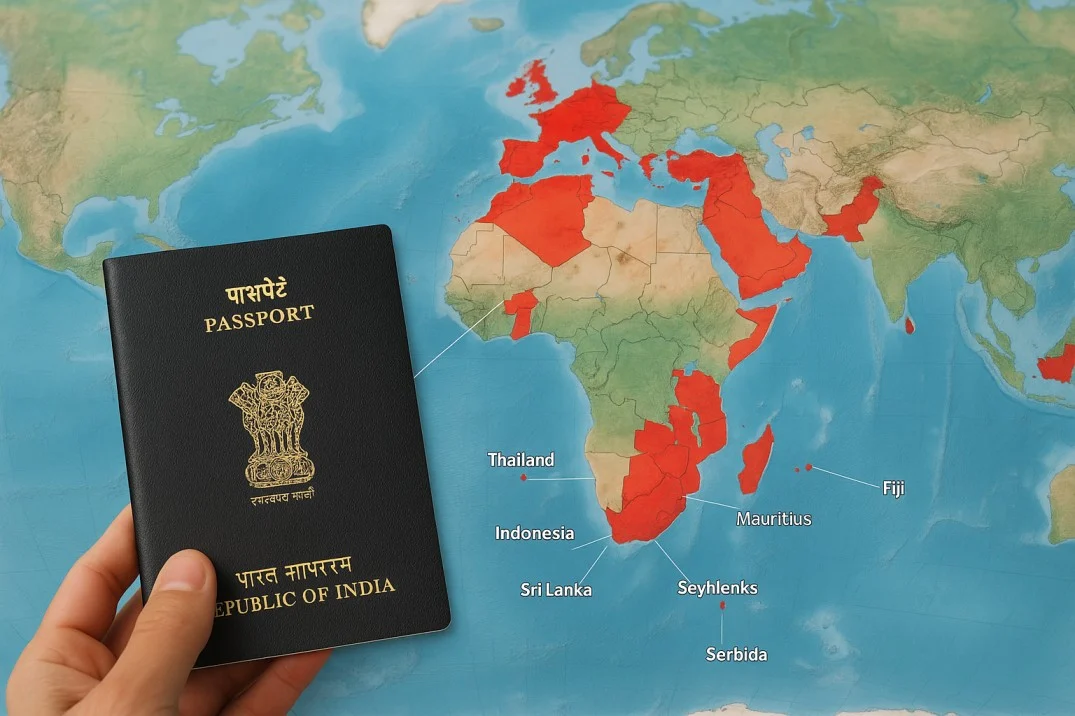“Traveling in India is expensive. How is it possible to travel on just ₹500 per day?
If this thought ever crossed your mind, you’re not alone. Most people assume travel requires thousands of rupees daily. But here’s the twist: India is one of the exceptionally few nations where you can explore mountains, beaches, cities, otherworldly towns, and villages without spending a fortune.
Yes, you studied it right. It’s completely conceivable to travel over India on ₹500 a day if you know the right hacks. Whether you’re a broke college student, a budget hiker, or basically somebody who appreciates basic travel over extravagance, this direct will appear you precisely how to make each rupee count.
And truly, the excite of budget travel is unmatched—you don’t just spare money, you encounter the nation more truly. From chatting with chaiwalas to jumping onto crowded buses, from remaining at hostels filled with strangers-turned-friends to finding delight in a ₹30 plate of momos, each small thing gets to be a story.
So, let’s dive in and find how to make the most of India without burning your wallet.
Why ₹500 a Day Is Realistic in India
India is a budget traveler’s dream. Street food under ₹50, dorm beds starting from ₹250, and public transport as cheap as ₹10 all add up to make budget travel completely doable.
Unlike many countries where $10 barely gets you a snack, in India ₹500 can buy you:
- A bed to sleep on
- Three proper meals
- Local transport
- And sometimes even an entry ticket to a monument!
The key is smart choices: pick local over luxury, simple over showy, and practical over fancy.
1. Affordable Stays
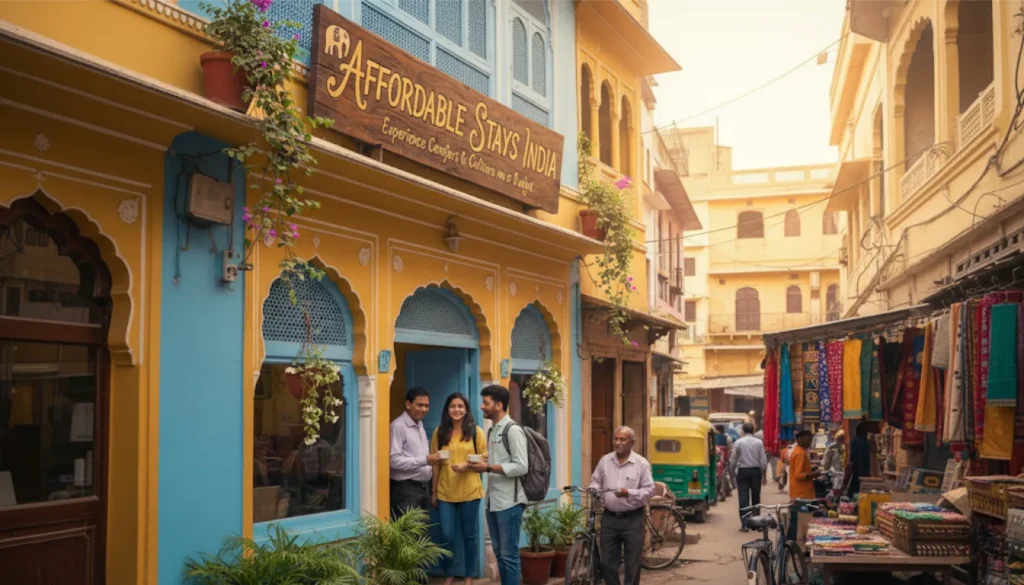
Beds Starting at ₹250 Because accommodation is your biggest expense, here is an awesome way to save on it when traveling in India.
- Hostel Dorms: Backpacker hostels like Zostel, Moustache, or GoStops have beds for ₹250-₹350 a night, So, for a small price, you have free WiFi, access to a common kitchen, and other travelers to socialize with.
- Ashrams & Dharamshalas: For Haridwar, Varanasi, or Puri you could try these religious towns. Rooms can be found for ₹100-200 and these are clean, and safe with simple meals provided.
- Couchsurfing: For an even bigger cost saving try Couchsurfing where you can connect with people and have an experience of a lifetime.
Tip: If your accommodations free complimentary breakfast it will save you ₹30-50 on a chai and a paratha each.
2. Food on a Budget: Full Meals Under ₹150
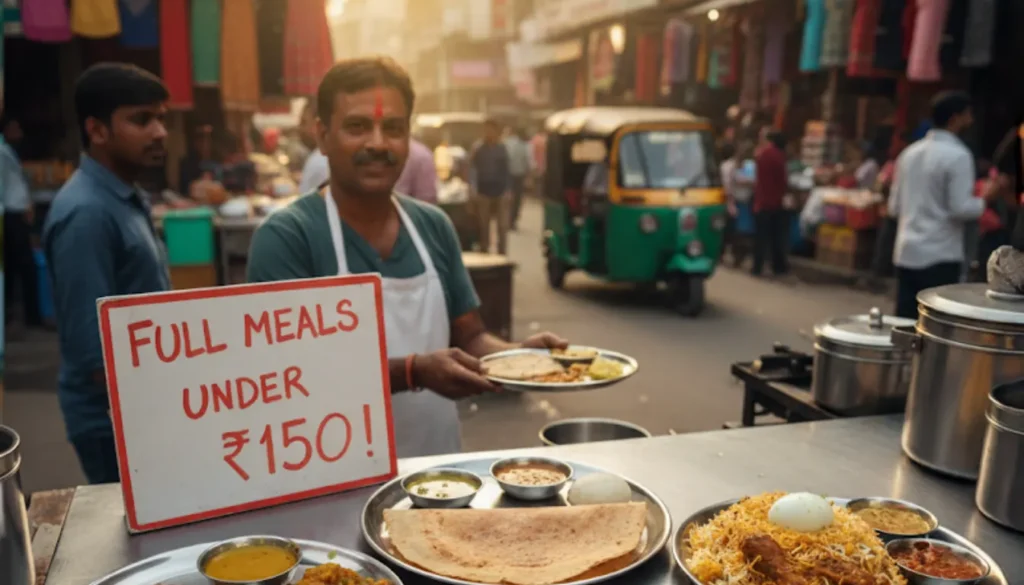
Traveling is incomplete without tasting India’s food. Luckily, eating well on a budget here is easy.
The good news is that you can do it without breaking the bank.
- For breakfast, you can have any of the following and a cup of tea for between ₹30 and ₹40: poha, idli, samosa, or parathas.
- For lunch or dinner, you can get a local thali, which includes dal, sabzi, rice, roti, and papad, for ₹70 and even up to ₹100. The portions are quite generous and are frequently unlimited.
- Snacks like vada pav in Mumbai, momos in Delhi, litti-chokha in Bihar, and pani puri sold anywhere are all under ₹30.
That’s breakfast, lunch, dinner, and snacks for about ₹120-150.
3. Getting Around
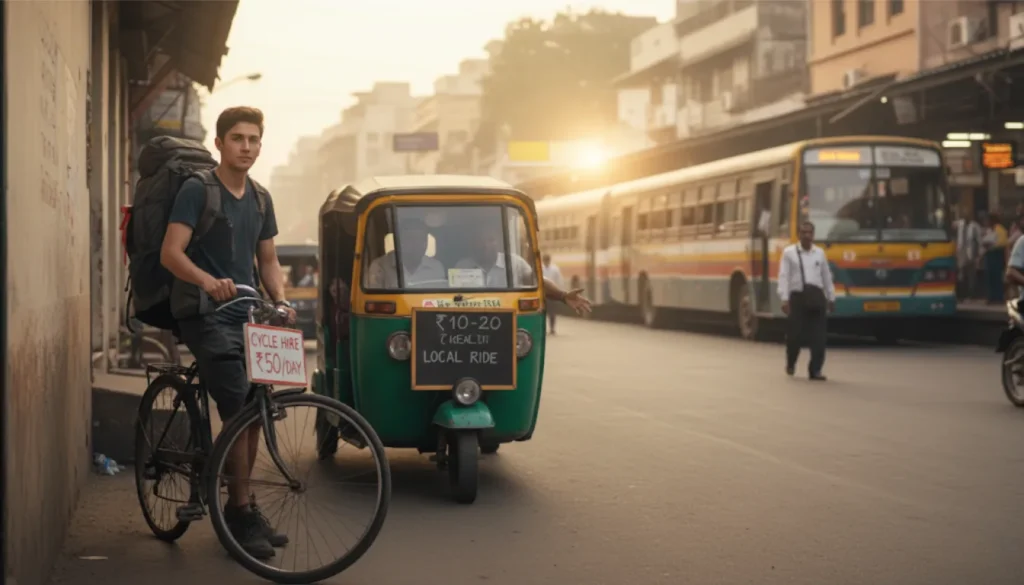
Transport in India’s public transport is made for budget travelers.
- City Transport: Nearby buses and shared autos charge ₹10–20 per ride. In Delhi and Bangalore, metro rides cost ₹20–40.
- Trains: Sleeper class train tickets for short distance (200–300 km) are around ₹100–150.
- Cycling/Walking: Numerous towns lease bikes for ₹50–100 a day, and of course exploring on foot is free.
Tip: Travel at night and save one night’s stay.
4. Sightseeing: Free or Almost Free.
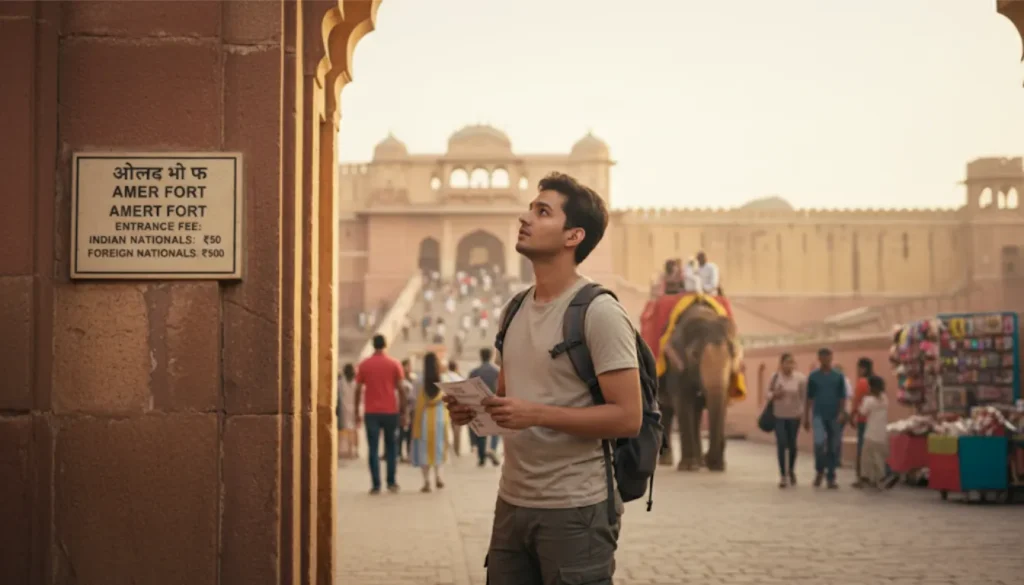
Not everything great has to cost money. There are beaches in Goa,the ghats in Varanasi, the bazaars in Jaipur, trekking in Himachal, or watching the Ganga aarti in Haridwar.
- Very Little: The Qutub Minar, Red Fort, or Amer Fort are about ₹30–50 for Indian citizens.
- Natural Beauty: Lakes, hills, waterfalls, and national parks which some charge ₹20–30, are always in budget.
5. Smart Routes: Save money with clustered travel.
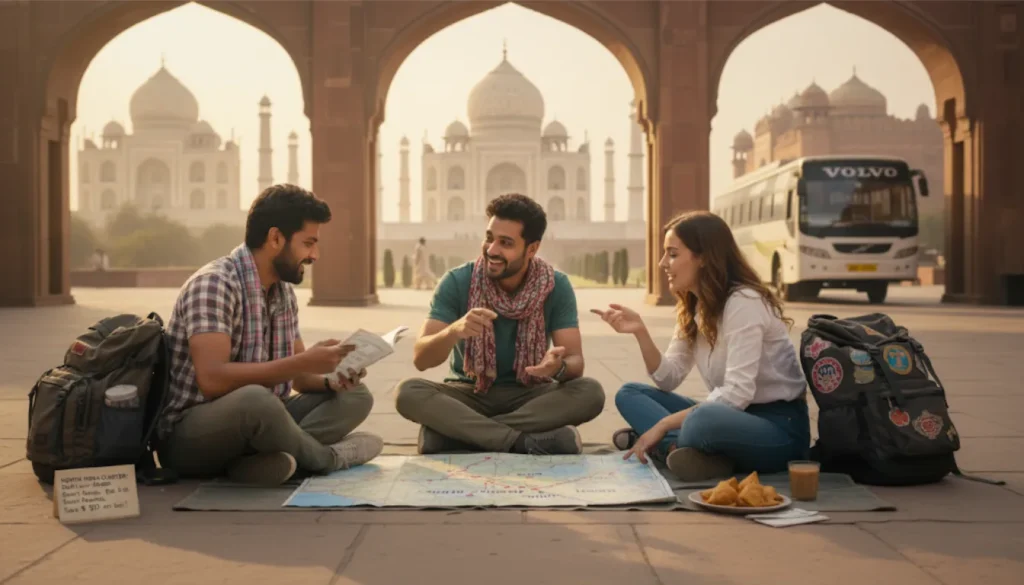
If you travel on a tighter budget, don’t zigzag across states. Instead, focus on clusters. This minimizes travel costs, and lets you spend time with a region. For example
- The North India Cluster: Delhi → Agra → Jaipur → Pushkar → Udaipur (cheap train/bus connectivity everywhere).
- Spiritual Cluster: Rishikesh → Haridwar → Dehradun → Mussoorie (short bus rides, budget ashrams, and nature spots).
- Beach Cluster: Goa → Gokarna → Hampi (bike rentals split, and free beaches).
- Himalayan Cluster: Manali → Kasol → Dharamshala → McLeodganj (perfect for trekking, dorm beds, and local buses are available for just ₹20–30).
Tip: Booking in advance reduces bus travel costs by ₹50–100.
6. A Sample ₹500 Day
Here’s how your day could look:
- Hostel dorm bed: ₹300
- Street food breakfast + thali lunch + dhaba dinner: ₹150
- Local transport: ₹40
- Monument entry/snack: ₹10
But this is just a rough idea. On some days, you might spend only ₹400 if you stay in an ashram or take a night bus. On other days, you may go slightly over ₹500 if you treat yourself to something special. The point is—on average, it balances out.
Pro Hack: Keep ₹50 aside daily as a buffer. This way, if an auto driver charges extra or you suddenly crave an ice cream, you won’t feel guilty.
7. Extra Hacks to save your money
Saving money is an art, and small decisions make a big difference.
- Off-Peak Traveling: In months like March-May and September, hostels offer around 30-40% discount.
- Free Breakfasts: Hostels should be chosen that provide free breakfast, thus saving time and money.
- Travel in Groups: Sharing rooms or bike rentals with a friend will halve the cost.
- UPI Payments: Some cafes and shops give a small discount for payments via online mode.
- Carry Snacks: Dry fruits, peanuts, or biscuits keep hunger at bay during all-day-long journeys.
Visit: Best Places to Visit In India This Festive Season
8. Regional Cost Examples
To give you a sense of range, let us start with beaches
- Goa: A dorm bed is ₹250, a seafood thali is ₹120, and a shared scooter, which costs ₹200 each, is easy to get. Beaches are free, and the coastal town snack shacks are cheap.
- For Varanasi: you can spend ₹150 to stay at an ashram, have a thali for ₹80, get chai for ₹10, and the Ganga aarti is free. For the spiritual, it is perfect.
- For Manali or Kasol: hostels are ₹300, you can get a mountain Maggi for ₹50, and trekking is free. Local buses are ₹20. For nature, perfect trip options.
- Jaipur: a hostel costs ₹280, entry into Amer fort is ₹40, lassi is ₹30, and you can get an auto for ₹20. For some cultures, and at a budget
- Calcutta: you get tram rides for ₹10, hostel beds for ₹300, and street food like rolls or chowmein for ₹40–₹50. Each one of these places gives you a sense of a different experience and does not hit the ₹500 limit.
What should be your strategy?
Traveling on a budget while maintaining safety and quality experiences is possible, as long as you avoid certain common pitfalls.
- Take Public Transport: Opting for a bus or metro is better, as cabs cost at least ₹200-300. If you need to use an auto, try to combine rides.
- Don’t Spend Too Much on Overpriced Drinks: Spending ₹200 on a coffee is not a good investment, and you can always pack a snack.
- Bargain: Street markets can be fun, but try not to overspend.
- Take a Small Bag: Less luggage means less auto fare and less to carry around, which is always a good thing. Prioritize Safety: Choose safe hostels and safe areas over unsafe, inexpensive accommodations.
Tip: Instead of overspending on luxe items, focus on affordable experiences.
Conclusion
Traveling in India on ₹500 a day isn’t just around overseeing expenses it’s around rethinking what travel implies. You don’t require favor resorts or five-star dinners to appreciate a place. What you truly require is interest, adaptability, and the readiness to get involved in life in a neighborhood way.
With ₹500 a day, you’ll find covered-up paths, taste nourishment that local people swear by, stay in places filled with stories, and collect recollections that no extravagance inn might ever deliver to you.
So, the following time somebody laughs and says, “Travel in ₹500? Impossible! Just grin and reply:“India hai dost, yahan sab conceivable hai.” Pack your sack, travel light, spend smart, and let India shock you one chai, one transport ride, and one unused fellowship at a time.

